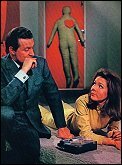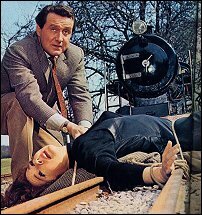You are hereMagazines 2000-2009 / The Avengers
The Avengers
 Macnee and Rigg.
Macnee and Rigg.
THE AVENGERS
Boxed Sets, 1963, 1964, 1965, 1966, 1967, 1968
BEST OF THE ORIGINAL AVENGERS
A&E Home Video
from SCARLET STREET, 2001
THE AVENGERS is back. A&E has been releasing DVD sets of the 1961-69 series for the last two years and now a viewer can sample almost everything that’s good, bad, and just plain silly about the unique British spy show. The program began life in 1961 as a vehicle for Ian Hendry, an up-and-coming star on the short-lived POLICE SURGEON. Hendry was paired with debonair Patrick Macnee as a suave but mysterious undercover operative named John Steed. The series, fairly conventional, was transformed in 1962 when Hendry left and his part was filled by a pre-GOLDFINGER Honor Blackman.
The actress starred as Mrs. Cathy Gale, a brainy beauty given to wearing tight black leather as she physically manhandled her foes. Partially modeled on Margaret Mead, the anthropologist, and Margaret Bourke-White, a well-known Life magazine photographer who handled dangerous assignments, Mrs. Gale was an anomaly for her day: a capable, independent, and beautiful female adventurer. Steed was unusual, as well. In his Edwardian outfits, bowler hat, and rolled-up umbrella, he was less a James Bond wannabe and more a parody of the British gentleman spy as seen in Alfred Hitchcock’s thrillers THE 39 STEPS (1935) and THE LADY VANISHES (1938).
The series went through many transformations during its long run: it began as live-on-videotape, with a studio-bound look, then went to black-and-white film, then to color. Its tone changed from dead serious to mock serious to serious mockery – and then to outright absurdity. As the tone changed, so did the cast: Blackman was replaced by the curvy Diana Rigg (as Mrs. Emma Peel) who was in turn replaced by the buxom Linda Thorson (as Miss Tara King). Through it all, the one constant was Macnee’s Steed, the one fixed point in a changing AVENGERS.
A&E has not yet released the 1962 season on DVD – the 1961 Hendry shows are lost except for “The Frighteners” – but you can catch one 1962 episode on THE BEST OF THE ORIGINAL AVENGERS compilation DVD. “Mr. Teddy Bear” is typical of the Blackman series. In it, Steed and Mrs. Gale trail an international assassin known as Mr. Teddy Bear. Almost all the later elements of the program are here in nascent form: Steed bantering with his leather-clad female partner; a bizarre murder or two; and a tongue-in-cheek approach to death. In typical style, the villain gives his instructions through a stuffed bear (an idea that was partially adapted for the dreadful big-screen Ralph Fiennes-Uma Thurman AVENGERS ). Because the show was shot live-on-tape, however, both the dialogue and the action sequences frequently come across as stilted.

The different approaches of the Blackman-Rigg year can best be seen by comparing “Don’t Look Behind You,” from the 1963 collection, with its color remake, “The Joker,” available on the 1967 set. In both versions, the heroine is trapped in a spooky mansion, menaced by an unseen madman. Macnee, in a commentary on BEST OF, says that it is arguable which version is better. Short argument. “Don’t” is dull, “The Joker” infinitely superior, long on moody atmosphere, clever set design, and top-notch performances.
In fact, you could say the same about almost all the Rigg-Macnee installments, which are, by and large, a joy to behold. For an early Rigg adventure, try “Death at Bargain Prices” (on the 1965 set), directed by Charles Crichton (A FISH CALLED WANDA). The story concerns strange goings-on at a department store: after a top agent is murdered there, Steed and Mrs. Peel discover a mad millionaire who is planning to blow up London with an atomic bomb. Steed uses a ping-pong gun, Mrs. Peel wears a leather outfit.
In “Too Many Christmas Trees,” another excellent adventure (also from the 1965 set), Steed is plagued by recurring nightmares featuring a satanic Santa Claus. Mervyn Johns (the dreamer in DEAD OF NIGHT) guest stars as a man obsessed with Dickens. This episode is top-drawer: moody and atmospheric, with a touch of fantasy/sci-fi tossed in to the mix; there is also an homage to the hall of mirrors sequence in LADY FROM SHANGHAI as Mrs. Peel is stalked by a gun-toting Santa Claus. Leave it to THE AVENGERS to do a Christmas story featuring a murderous Father Christmas.
Finally, there is Tara King, Steed’s fourth partner (his final female partner was Joanna Lumley, before ABSOLUTELY FABULOUS, who co-starred with Macnee in the 1976 revival THE NEW AVENGERS). By 1968-69, the series was almost an outright farce, eschewing the balance between comedy and thrills that had worked so well in the Rigg years. “Look (Stop Me If You’ve Heard This One)...” from the recently released 1968 set, is very arch comedy, going over the edge into the world of high-camp. The story showcases two killer clowns, old vaudevillians – vaude villains, if you will – who don’t accept that vaudeville is dead; in fact, their jokes kill – literally. John Cleese, pre-MONTY PYTHON, and well-known Brit comedian Bernard Cribbins have featured parts as eccentric victims. Contrary to popular opinion, Thorson is fine as the heroine – winsome and sweet, a welcome change from the hard-edged Blackman.
“All Done With Mirrors,” also from 1968, finds Tara on her own, investigating the theft of secret documents from a top-secret naval installation. Steed is written out and Tara is partnered with a nitwit agent named Watney who does very little. The plot is thin, and the series is clearly running on empty, repeating incidents from previous episodes. As it is, you have to make due with one good fight sequence and some cool camera angles.
Except for the Blackman episodes, the sound and image quality on all the sets is excellent. As for extras, there are publicity stills on every set and the BEST OF collection has introductions by Macnee (in which he reveals some deathless trivia: did you know that Blackman’s leather outfits were green not black because of the limits of then-current technology?) A & E has also included a couple of rarities on BEST OF: the U.S.-only opening credits sequence for the 1965-66 season and a short film shot to promote Thorson. All in all, a tip of the bowler hat for the return of this memorable series. – Tom Soter
